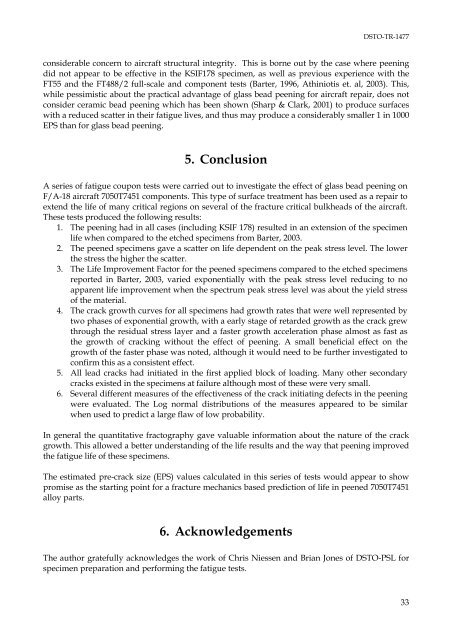Fatigue Crack Growth in 7050T7451 Aluminium Alloy Thick Section ...
Fatigue Crack Growth in 7050T7451 Aluminium Alloy Thick Section ...
Fatigue Crack Growth in 7050T7451 Aluminium Alloy Thick Section ...
Create successful ePaper yourself
Turn your PDF publications into a flip-book with our unique Google optimized e-Paper software.
DSTO-TR-1477considerable concern to aircraft structural <strong>in</strong>tegrity. This is borne out by the case where peen<strong>in</strong>gdid not appear to be effective <strong>in</strong> the KSIF178 specimen, as well as previous experience with theFT55 and the FT488/2 full-scale and component tests (Barter, 1996, Ath<strong>in</strong>iotis et. al, 2003). This,while pessimistic about the practical advantage of glass bead peen<strong>in</strong>g for aircraft repair, does notconsider ceramic bead peen<strong>in</strong>g which has been shown (Sharp & Clark, 2001) to produce surfaceswith a reduced scatter <strong>in</strong> their fatigue lives, and thus may produce a considerably smaller 1 <strong>in</strong> 1000EPS than for glass bead peen<strong>in</strong>g.5. ConclusionA series of fatigue coupon tests were carried out to <strong>in</strong>vestigate the effect of glass bead peen<strong>in</strong>g onF/A-18 aircraft <strong>7050T7451</strong> components. This type of surface treatment has been used as a repair toextend the life of many critical regions on several of the fracture critical bulkheads of the aircraft.These tests produced the follow<strong>in</strong>g results:1. The peen<strong>in</strong>g had <strong>in</strong> all cases (<strong>in</strong>clud<strong>in</strong>g KSIF 178) resulted <strong>in</strong> an extension of the specimenlife when compared to the etched specimens from Barter, 2003.2. The peened specimens gave a scatter on life dependent on the peak stress level. The lowerthe stress the higher the scatter.3. The Life Improvement Factor for the peened specimens compared to the etched specimensreported <strong>in</strong> Barter, 2003, varied exponentially with the peak stress level reduc<strong>in</strong>g to noapparent life improvement when the spectrum peak stress level was about the yield stressof the material.4. The crack growth curves for all specimens had growth rates that were well represented bytwo phases of exponential growth, with a early stage of retarded growth as the crack grewthrough the residual stress layer and a faster growth acceleration phase almost as fast asthe growth of crack<strong>in</strong>g without the effect of peen<strong>in</strong>g. A small beneficial effect on thegrowth of the faster phase was noted, although it would need to be further <strong>in</strong>vestigated toconfirm this as a consistent effect.5. All lead cracks had <strong>in</strong>itiated <strong>in</strong> the first applied block of load<strong>in</strong>g. Many other secondarycracks existed <strong>in</strong> the specimens at failure although most of these were very small.6. Several different measures of the effectiveness of the crack <strong>in</strong>itiat<strong>in</strong>g defects <strong>in</strong> the peen<strong>in</strong>gwere evaluated. The Log normal distributions of the measures appeared to be similarwhen used to predict a large flaw of low probability.In general the quantitative fractography gave valuable <strong>in</strong>formation about the nature of the crackgrowth. This allowed a better understand<strong>in</strong>g of the life results and the way that peen<strong>in</strong>g improvedthe fatigue life of these specimens.The estimated pre-crack size (EPS) values calculated <strong>in</strong> this series of tests would appear to showpromise as the start<strong>in</strong>g po<strong>in</strong>t for a fracture mechanics based prediction of life <strong>in</strong> peened <strong>7050T7451</strong>alloy parts.6. AcknowledgementsThe author gratefully acknowledges the work of Chris Niessen and Brian Jones of DSTO-PSL forspecimen preparation and perform<strong>in</strong>g the fatigue tests.33
















